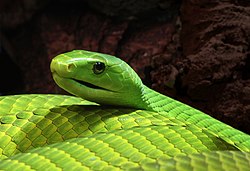Mamba
A mamba is a fast-moving venomous snake of the genus Dendroaspis (means "tree asp").[2] It belongs to the Elapidae family.
| Mamba | |
|---|---|

| |
| Black mamba | |
| Scientific classification | |
| Unrecognized taxon (fix): | Dendroaspis |
| Species | |

| |
D. polylepis
D. angusticeps
D. viridis
| |
They are native to Africa. The black mamba is one of the well-known species and is also the most feared. Other members include the eastern green mamba, western green mamba and Jameson's mamba.
Behavior
Most mambas are arboreal, meaning they live in trees. The only exception is the black mamba, which lives on land. All mamba species hunt during the day. They prey on birds, lizards and small mammals.
There are many stories of mambas chasing humans, but these snakes usually prefer to avoid contact with humans.[3][4] Humans are actually their main predators, rather than prey.[3]
Because mambas and cobras are in the same family, they share some similarities. Like the cobra, a mamba might display a hood when threatened. However, a mamba's hood is more narrow and is longer. A mamba usually opens its mouth when threatened, so they lean forward unlike the cobra which usually stands erect.
Venom
All mambas are very venomous. Their venom is mostly comprised of neurotoxins, which attack the nervous system. The venom can also contain cardiotoxins (which damage the heart muscle)[3][5] and fasciculins (which cause muscle twitches).[6][7]
The toxicity of the venom varies. Changes in the toxicity can even be caused by the weather or altitude.
All mamba species have similar venom, but the black mamba has the most toxic venom and is more aggressive.
Mamba Media
References
- ↑ Dendroaspis (TSN {{{ID}}}). Integrated Taxonomic Information System.
- ↑ Dendroaspis (TSN {{{ID}}}). Integrated Taxonomic Information System.
- ↑ 3.0 3.1 3.2 "National Geographic (Black Mamba, Dendroaspis polylepis)". National Geographic Society. Retrieved 5 July 2013.
Black mambas are shy and will almost always seek to escape when confronted.
- ↑ 4.0 4.1 O'Shea, Mark (2005). VENOMOUS SNAKES OF THE WORLD. multiple places: US and Canada: Princeton University Press; Europe: New Holland (UK) Ltd. pp. 78–79. ISBN 978-0-691-15023-9.
...in common with other snakes they prefer to avoid contact;...Of the three species of green mambas...;...from 1957 to 1963...including all seven black mamba bites - a 100 per cent fatality rate
- ↑ van Aswegen G, van Rooyen JM, Fourie C, Oberholzer G. (May 1996). "Putative cardiotoxicity of the venoms of three mamba species". Journal of Wilderness and Environmental Medicine. 7 (2): 115–21. doi:10.1580/1080-6032(1996)007[0115:PCOTVO]2.3.CO;2. PMID 11990104.
{{cite journal}}: CS1 maint: uses authors parameter (link) - ↑ Fasciculin
- ↑ Neurotoxins in Snake Venom[dead link]
- ↑ Davidson, Terence. "IMMEDIATE FIRST AID". University of California, San Diego. Archived from the original on 2012-11-02. Retrieved 2011-09-22.




